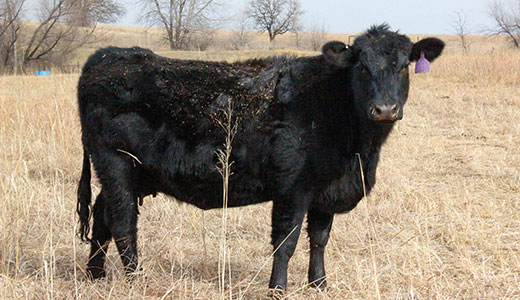
The depreciating value of replacement heifers and cows should be factored in to a whole herd budget. | Download this photo.
The hidden cost of cow depreciation
K-State experts advise beef producers on ways to minimize this expense
December 9, 2019
MANHATTAN, Kan. – When asking cow-calf producers what it costs to raise cattle, often they will list feed and equipment as two of the largest expenses they have. Others might include labor on the list.
But experts at Kansas State University say that one cost not often thought of or accounted for is the decreasing value of the cow over time.
“Labor, interest, machinery and feed are all cash expenses,” said agricultural economist Dustin Pendell during a recent Beef Cattle Institute podcast. “Cow depreciation is a non-cash expense, which is why a lot of times people don’t think about it.”
Assessing the depreciation value
In accounting for cow depreciation, Pendell said cattle producers need to calculate the purchase price minus the salvage value divided by the productive life of the animal.
“The price you pay for the cow or replacement heifer will have a huge impact on the depreciation value,” he said.
As an example, veterinarian and Beef Cattle Institute director Brad White said: “As you think about your herd, there might be years when a pregnant replacement heifer could be added for $1,300, and other years when that same heifer might cost $2,100 depending on the cattle cycle. That purchase price greatly impacts the level of depreciation.”
Another factor is the span of time the cow is in the herd. White advises producers to think broadly about the whole herd. “We are talking about more than just one cow. How long do she and her cohorts stay in the herd on average?” he said.
Then there is the final sale price. Market trends will influence that decision, according to Pendell. “Producers need to decide if it is better to sell her as a cull cow now or feed her over the winter and try for a better price in the spring.”
Understanding a dollar cost averaging approach
Along with accounting for cow depreciation, White recommended producers consider a dollar cost averaging approach. With this strategy, cow-calf operators budget a fixed dollar amount annually for buying or raising replacements.
White made an analogy to the stock market to explain this concept. “Think about how we invest in the stock market. We don’t know when the highs and lows will be so we just allocate a set dollar value to invest,” he said. “And that is the difference between keeping 15 heifers every year versus keeping $15,000 worth of heifers. With the second approach, that $15,000 will buy us 20 heifers in some years and in other years just 10.”
White said this approach allows producers to plan more and take some of the guesswork out of their budgeting. “This is a cost that producers can manage that will impact the overall profitability of the herd.”
More information on this topic is available on a weekly podcast produced by the Beef Cattle Institute.
